DeLongTODAY: Biden Building Back Better: Will It Work?
My initial thoughts on the second of the three tranches of Biden's 100-days program...
<https://youtu.be/3vftOMtAtgU>
This is the DeLongTODAY Briefing.
I am Brad DeLong, an economics professor at the University of California at Berkeley, and a sometime Deputy Assistant Secretary of the U.S. Treasury. This is the weekly DeLongToday briefing. Here I hold forth here on the Leigh Bureau’s vimeo platform on my guesses as to what I think you most need to know about what our economy is doing to us right now.
I promised Wes Neff when he agreed to provide the infrastructure for this that I and my briefings would be: lively, interesting, curious, thoughtful, and relatively brief.
Relatively.
I promised I would provide briefings on a mix of: forecasting, politics, macroeconomic analysis, history, and political economy.
Today is a political economy briefing.
But first, Friday morning saw a very good employment report.
Six more months of this, and I will start to think that maybe Larry Summers and Olivier Blanchard have a point with their fears that perhaps Biden’s $1.9 trillion Rescue plan was a bit too large to be optimal.
The U.S. labor market added 916,000 jobs, seasonally adjusted, comparing March to February. The prime-age employment-to-population rate increased by 0.3 percentage points and is now back to where it was in 2014, halfway through the anemic post-2009 recovery. Inadequate. But no longer totally disastrous. Employment growth in March was led by leisure and hospitality and education services, as in-person activity was able to resume—alongside a notable increase in construction. Wages fell—but that is a good sign: it means that low-wage employment is coming back as herd immunity approaches. Perhaps, if anything, it is coming back too fast—reopen prematurely, and we could have another excessive and avoidable 100,000 deaths from the COVID-19 plague.
It had been a Latin-cession to a remarkable degree: Latin unemployment rose by `15%-points while white unemployment rose by 11%-points at the nadir, but now Latin unemployment is close to back to having its “normal” elevation over white—things are no worse than they are usually.
As I said, six more months of this of favorable employment reports like this, and I will start to think that maybe Larry Summers and Olivier Blanchard have a point with their fears that perhaps Biden’s $1.9 trillion Rescue plan was a bit too large to be optimal.
But the $1.9 trillion Rescue plan is now law. And now the Biden administration has moved on, to “jobs"—the “American Jobs Plan". It is infrastructure and corporate taxes—what I call “Rebuild”, in an attempt to find alliteration here.
What does it hope to do?
Let me focus first on the corporate tax part—on the international corporate tax part—since that is the area on which my views are somewhat better developed. Biden calls it the “Made in America Tax Plan”. And, yes, as a card-carrying neoliberal globalist, the “made in America” part makes me wince. Economic nationalism, in my experience, turns what ought to be a win-win-countries-cooperate discussion frame into a win-lose-countries-struggle-for-position discussion frame which winds up with lose-lose policies.
Yet when I look at the substance, it looks good. The Biden administration says that “the President is proposing to fix the corporate tax code so that it incentivizes job creation and investment here in the United States”. I would say that “the President is proposing to fix the corporate tax code to remove provisions that destructively and improperly incentivize job creation and investment outside the United States”—because that is what it does. And I have no quarrel whatsoever with the other two objectives as they are stated:
“stops unfair and wasteful profit shifting to tax havens, and ensures that large corporations are paying their fair share…”
Let me back up to 2017. The 2017 Ryan-McConnell-Trump corporate tax cut reduced the average rate that corporations paid in half from 16 percent to less than 8 percent in 2018. It created remarkably powerful—and stupid—new incentives to shift profits and jobs overseas. The economist shills shilling for it claimed that it would ignite another boom like the 1990s—generate as large a shift in American spending away from current consumption and toward investment for the future as we saw had been unleashed by and came in the wake of the Clinton 1993 fiscal-rebalancing Reconciliation bill.
It did not deliver.
To first order, it had zero effect on investment in America. Before the COVID-19 plague hit, the share of national income devoted to investment spending had already begun to fall. To the extent that companies subject to American taxes responded to Ryan-McConnell-Trump by increasing investment, they did so overseas. At home, they did share buybacks and acquisitions. Nearly exclusively.
To produce a corporate tax cut that does not boost firms’ incentives to increase investment at home at all is a remarkable thing to accomplish—a rare demonstration of total incompetence or total corruption in the details of legislation design.
And yet the Republican shill economists—from George Shultz to John Taylor, from Mike Boskin to Kevin Hassett, from Casey Mulligan and John Cochrane to Jagdish Bhagwati and Douglas Holtz-Eakin—all trumpeted that the bill would boost investment in America and economic growth by enough for the tax cut to “pay for itself”: an extra 0.5%-points of GDP growth per year, and not a higher but a lower federal debt. And others who weren’t willing to go that far—the Robert Barros and the Greg Mankiws—were still enthusiastic cheerleaders for how it would raise growth and raise after-tax wages because the growth effects would outweigh the adverse redistribution effects.
Of course, none of this happened.
It was never going to happen.
And now Joe Biden and his administration are trying to fix it. And they are trying to fix it in a smart way: not just to roll things back to how they were in 2016, but to make important tweaks to significantly improve the workings of the corporate tax code and system.
Biden wants to: (1) set the corporate tax rate at a moderate 28%, (2) impose a country-by-country minimum tax on U.S. corporations to 21 percent to capture profits in tax havens, (3) eliminate allowance of zero taxes on the first 10 percent of return for investments in foreign countries.
More important, and in fact the key part of Biden’s proposal, is international tax harmonization. Cooperate with German and Japanese proposals that have already been made for international minimum corporate tax harmonization through multilateral negotiations.
And if a country is an international scofflaw—if it refuses to play by the new multilateral rules of the game? Then any payments to corporations headquartered in such tax-haven counties will be denied deductions: they will be deemed as profit, and taxed as profits.
And, of course, Biden wants to fund the corporate tax division of the IRS at a level so that it can do its job.
Will this all work? This all will work if the Biden administration is, in fact, able to actually find the Holy Grail in this issue area: able to achieve multilateral international minimum tax harmonization. The stars appear to be aligned: the other major industrial powers—Germany, Japan, and so forth—are tired of being played for saps. The tax-haven countries—Ireland, Luxembourg, et cetera—have no bargaining power, and depend on complaisant U.S. legislators blocking legal provisions to enable enforcement. The only loose cannons on the deck are Boris Johnson’s Britain, and the ability of tax-haven countries and plutocrats who benefit from them to block the international-negotiation process. We will see how it will work. But this time the stars do appear aligned: this time Democratic legislators appear to understand that it is important for their long-run ability to govern that Biden enact good policies that actually work, and that they be seen to support Biden.
The problem is that Biden needs them all—all the Democrats. If any of them decide that they would rather satisfy plutocrat or tax-haven lobbyists at the expense of good policy and at the cost of doing significant damage to the Democratic Party’s reputation as an effective party for responsible governance, then the Made-in-America tax act fails. It fails unless there are Republican legislators more interested in good policy and in reducing the deficit than in confronting Biden with a united anti-every-tax Republican Party. As for that getting of Republican votes, good luck.
In my view, the best way to get Republican votes is not to need them—to have a clear road to enactment that does not require them. Recall Senator Harry Reid’s description of Senator Susan Collins: “always there for a vote when you do not need hers”.
The stars on the Made-in-America tax act are aligned, but not very aligned. It would be a very good thing for America, and for the world, if it were to pass. I put its chances at no more than 50%.
Now let me turn to the “infrastructure” part…
On his SubStack weblog Friday morning, Matthew Yglesias wrote that <https://www.slowboring.com/p/joe-bidens-next-big-plan>:
I would have quietly sent an emissary to Roger Wicker and Sam Graves, the ranking members on the Senate and House transportation committees, and told them that Biden is really eager to get a bipartisan infrastructure bill done. He has a few specific priorities related to clean electricity and clean water that he’d like to get in there, but… [since] a bipartisan infrastructure bill is a win for Biden… if he wants that win he needs to defer to Republicans on the substance…. [Biden’s] “raise taxes on the rich [via their ownership of corporations] to fund infrastructure spending”… means your infrastructure bill has to be highly partisan. And I think a highly partisan infrastructure bill is tough…
The big problem I see with Matt Yglesias’s alternative is that it was what Obama proposed for ObamaCare, the ACA: since a bipartisan universal healthcare bill was a big win for Obama, he decided that he needed to give a lot of ground on the substance, and so wound up enacting… nationwide RomneyCare. And he wound up enacting nationwide RomneyCare with 100% Democratic votes. And then partisan Republicans on the Supreme Court and in the Congress kneecapped it. And they were only kept from killing it when they realized that it had been in place long enough that they would then own the destructive substantive policy fallout.
What is different now than in 2009-10 that would make the Matt Yglesias strategy work for infrastructure now when it did not work for healthcare then? Anybody? Anybody? Bueller?
Now you can make the argument that this time things are different. After all, also Friday morning, former Speaker of the House John Boehner wrote:
I also had not anticipated… the extent to which this new crowd hated—and I mean hated—Barack Obama…. When I was first elected to Congress… there was no Drudge Report. No Breitbart. No kooks on YouTube spreading dangerous nonsense like they did every day about Obama. “He’s a secret Muslim!” “He hates America!” “He’s a communist!” And of course the truly nutty business about his birth certificate. People really had been brainwashed into believing Barack Obama was some Manchurian candidate planning to betray America. Mark Levin was the first to go on the radio and spout off this crazy nonsense. It got him ratings, so eventually he dragged Hannity and Rush to Looneyville along with him. My longtime friend Roger Ailes, the head of Fox News, was not immune to this. He got swept into the conspiracies and the paranoia and became an almost unrecognizable figure…. Murdoch… cared about ratings and the bottom line… wanted to make sure he was ahead of any political or policy developments…. If he entertained any of the kooky conspiracy theories… tak[ing] over his network, he kept it a secret from me. But he clearly didn’t have a problem with them if they helped ratings…
Of course, Boehner wants to say “both sides”:
Obama didn’t help himself much either. He could come off as lecturing and haughty. He still wasn’t making Republican outreach a priority…
But he cannot maintain it—after all, Obama outreached to Boehner just fine. As Boehner admits:
On the other hand—how do you find common cause with people who think you are a secret Kenyan Muslim traitor to America?…
Are things different now than they were then? The argument that they are is that things are different because Joe Biden is a white man and not a Black man, and that Obama’s failure to elicit Republican cooperation was overwhelmingly because of Republican racist-adjacency. The arguments against are (a) it needs to be “overwhelmingly” and not “substantially”, (b) that ceding substantive policy ground to the Republicans is making bad, destructive policies, and (c) that Fox News is working as hard as possible to Obamaize Biden. Look at its front page as of the taping:
Hunter Biden. Democrats trying to steal elections. Crisis at the border. Democrats surrendering to Iranian Muslim terrorists. Pope Francis celebrates Good Friday. Tucker Carlson says that tobacco is an effective anti-obesity medication. And below the fold Sean Hannity claiming that Joe Biden is “waging ‘all-out assault’ on American principles…”
As Boehner says of the Republican members of Congress who entered in the 2010s:
Incrementalism? Compromise? That wasn’t their thing. A lot of them wanted to blow up Washington. That’s why they thought they were elected. Some of them, well, you could tell they weren’t paying attention because they were just thinking of how to fundraise off of outrage or how they could get on Hannity that night…. They didn’t really want legislative victories. They wanted wedge issues and conspiracies and crusades…. [A] power base thanks to fawning right-wing media and outrage-driven fundraising cash. And… a new head lunatic…. There is nothing more dangerous than a reckless asshole who thinks he is smarter than everyone else. Ladies and gentlemen, meet Senator Ted Cruz…
Without a very different set of Republican legislators in the Congress—ones who work for their constituents rather than for Fox News and their fundraising firms—no, things have to be done via Reconciliation—or under threat of Reconciliation—and via the Democratic caucus alone—or under threat of doing it via the Democratic caucus alone.
So what is the problem that Infrastructure Week wants to solve? This:
With the end of the space race to the moon and of the massive spurt of interstate highway construction, plus a few other factors, U.S. government investment in America fell from its Eisenhower-Kennedy-Johnson norm of 6.5% of national income down to 4.75%, where it remained until the early 1990s. Then Clintonian austerity—the belief in the early 1990s that the U.S. had reached the edge of its debt capacity, and needed to stop borrowing—pushed U.S. government—all levels—down to 4% of national income. Back in 1993 I would have told you that this austerity was certainly the right thing to do. Now I will only say that it was probably the right thing to do—for the time. And then after 2010 Obama’s searching for a “grand bargain” on entitlements with the Republicans opened the way to a further downward salami slice of public investment in America, down to only 3.5% of national income.
This fifty-year policy move away from investment has been a horrible mistake.
This mistake was mitigated by the fact that, for the most part, private investment in America has remained healthy. Yes, the Reagan deficits switched savings from funding investment in America to buying government bonds and so putting substantial downward pressure on private investment, but Clinton reversed that and boosted private investment spending by 5%-points of national income back to healthy levels. But, unfortunately, the failure to prioritize full employment generated the anemic recovery from the Great Recession which has left the private nominal investment share of national income once again well-short of historical norms. If we are continuing to invest at a healthy rate, it is not because of the flow of spending into investment but because of reduced prices of products in the investment-goods sector.
Biden wants to boost investment in America back not to its 1950s and 1960s share but at least to its 1970s and 1980s share. Note that while Biden says that “public domestic investment as a share of the economy has fallen by more than 40 percent since the 1960”, he does not promise to boost it all the way back. All he says is that the “American Jobs Plan will invest in America in a way we have not invested since we built the interstate highways and won the Space Race” to the moon—note the since, not “as” but “since”.
Nevertheless, this strikes me as a highly good thing. Fix highways, rebuild bridges, upgrade ports, airports and transit systems. Deliver clean drinking water, a renewed electric grid, and high-speed broadband to all Americans. Build, preserve, and retrofit more than two million homes and commercial buildings, modernize our nation’s schools and child care facilities, and upgrade veterans’ hospitals and federal buildings. Solidify the infrastructure of our care economy by creating jobs and raising wages and benefits for essential home care workers. Revitalize manufacturing, secure U.S. supply chains, invest in R&D, and train Americans for the jobs of the future—$2 trillion dollars over 8 years, 1%-point of national income switched to public investment, that is not nearly enough to attain all of these goals. It will, however, be a start. Turning a supertanker is a lengthy process. And this infrastructure deficit has been built up over two generations now.
Perhaps the most interesting thing here is the reaction of the Republican Party to Biden’s laundry list here. Rising “star”—in quotation marks—Republican Governor Kristi Noem: “I was shocked by how much doesn’t go into infrastructure. It goes into research and development, it goes into housing and pipes and different initiatives, green energy, and it’s not really an honest conversation we’re having about what this proposal is…”
As the very sharp Greg Sargent writes:
The… distinction Noem drew… between “infrastructure” on one hand, and “research and development” and “green energy”…. Republican lawmakers have increasingly equated infrastructure with new highways that connect rural communities and promote exurban sprawl…. They see most of what Biden proposed as “Democratic infrastructure”…
Things used to be very different. After the launch of Sputnik, for example, for the federal government to spend whatever it took to produce universities and scientists and high technology became priority No. 1 of the Republican Party. Education and engineering in high technology became the key piece of lacking American infrastructure that the Eisenhower administration wanted to create. IT was essential to America achieving its national purposes
That’s from my book, written five years ago with Stephen S. Cohen, Concrete Economics: The Hamilton Approach to Economic Policy. It was a plea for pragmatism rather than ideology in political economy—and a sotto voce word of advice to Republicans to return their party to what it was before Goldwater cursed them and enslaved them to the demons of racism. Back then they thought the point was to make the American economy stronger, more dynamic, and more rapidly changing, because we are a frontier people and today’s frontiers are technological. And, yes, there would be some big winners, but (a) that was a positive point and (b) in the long run nearly everyone would be a winner.
Alas, now—and more and more with each passing day, at least if you listen to John Boehner or with the Lincoln Project people—the Republican Party has become a party of plutocrats and white racist-adjacents who greatly fear change and dynamism, because for the plutocrats—especially the heirs and heiresses—growth, dynamism, and change are their enemies because it is their wealth that dynamic Schumpeterian capitalism creatively destroys, and because for the racist-adjacents growth, dynamism, and change brings the possibility that people who look different will not bow heads but instead will look them in the eye.
So, once again, what ought to be an easy bipartisan lift—restore America’s public investment to boost productivity growth and lift all votes—will be a heavy lift that will have to be accomplished by the Democratic legislative caucuses alone, or possibly it will gain bipartisan support only after the Democrats demonstrate that they could do it alone.
And so, once again, I give it chances of only 50-50.
I wish I were more confident that America is getting back on track than I can convince myself that it is.
This is the DeLongTODAY Bradcast Briefing. I’m Brad DeLong. Thank you very much for watching.
(Remember: You can subscribe to this… weblog-like newsletter… here:
There’s a free email list. There’s a paid-subscription list with (at the moment, only a few) extras too.)






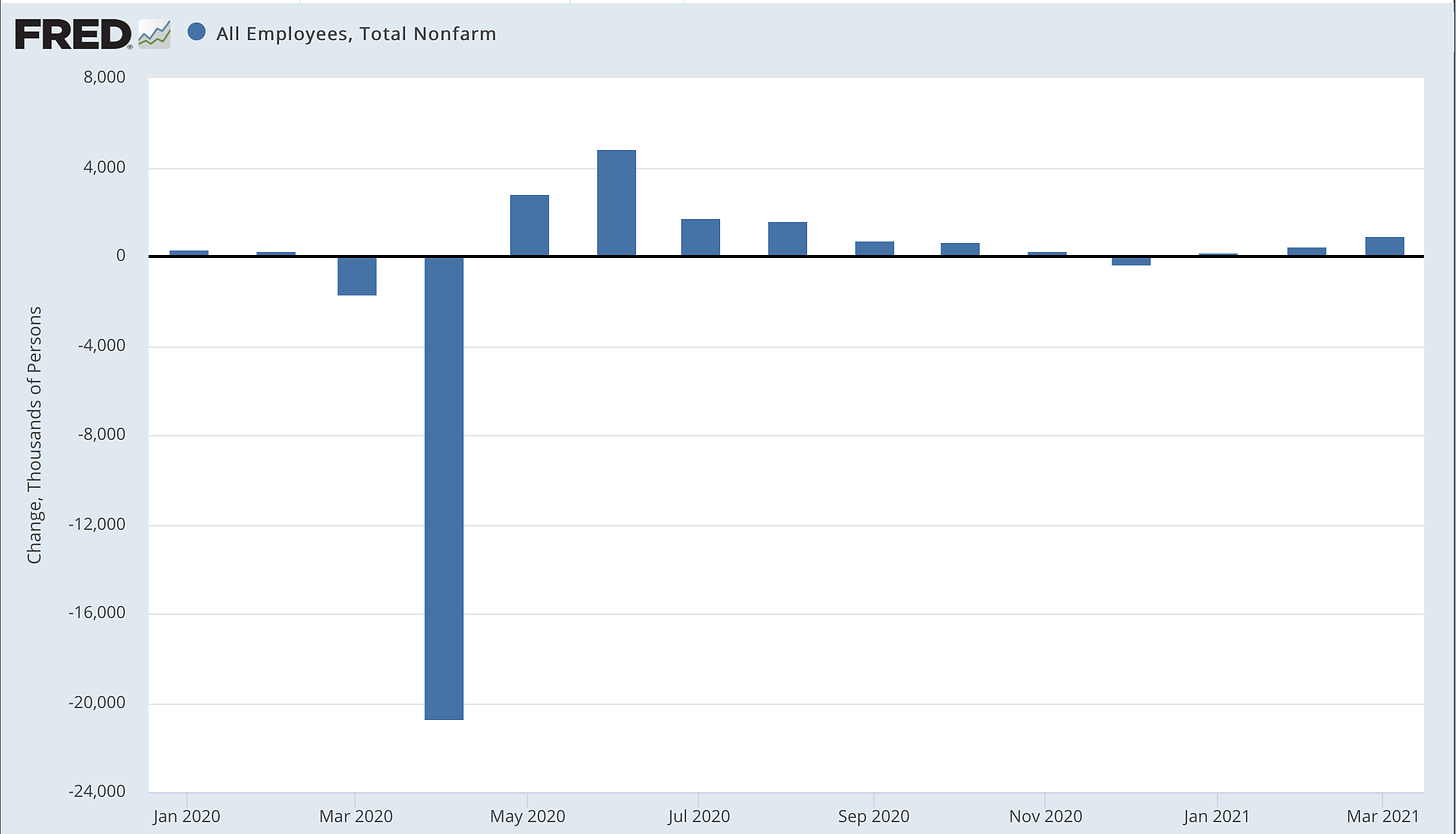

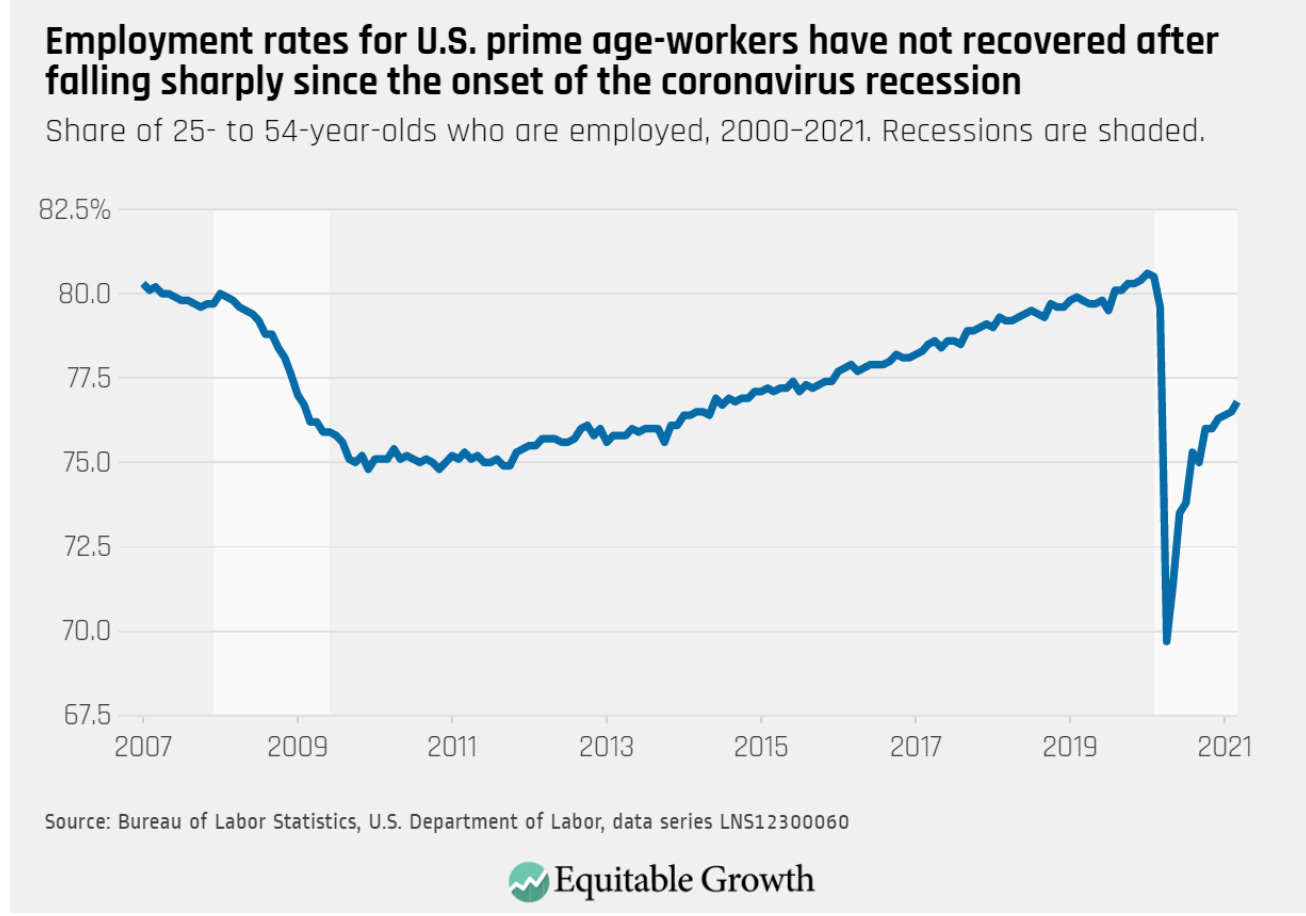

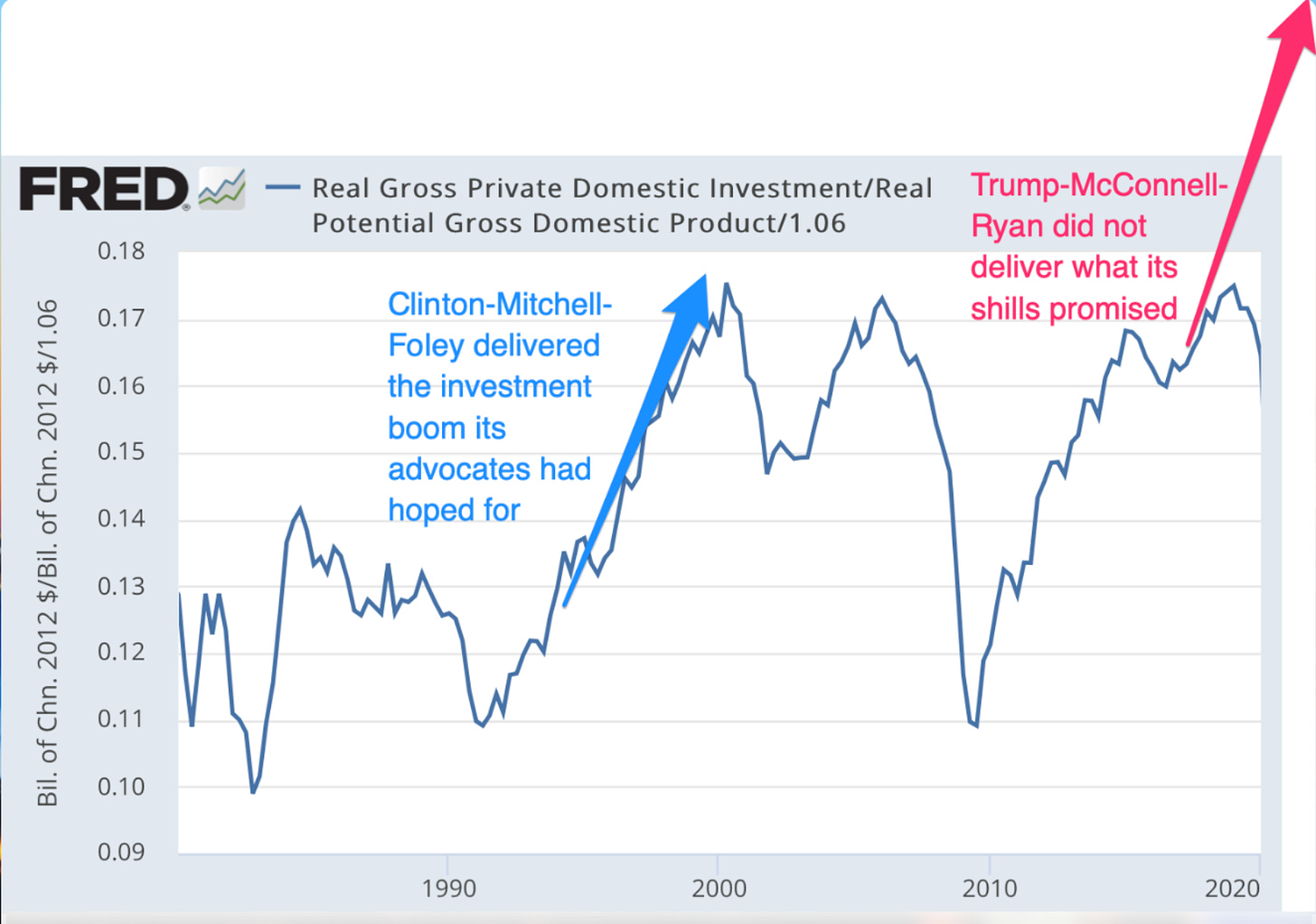
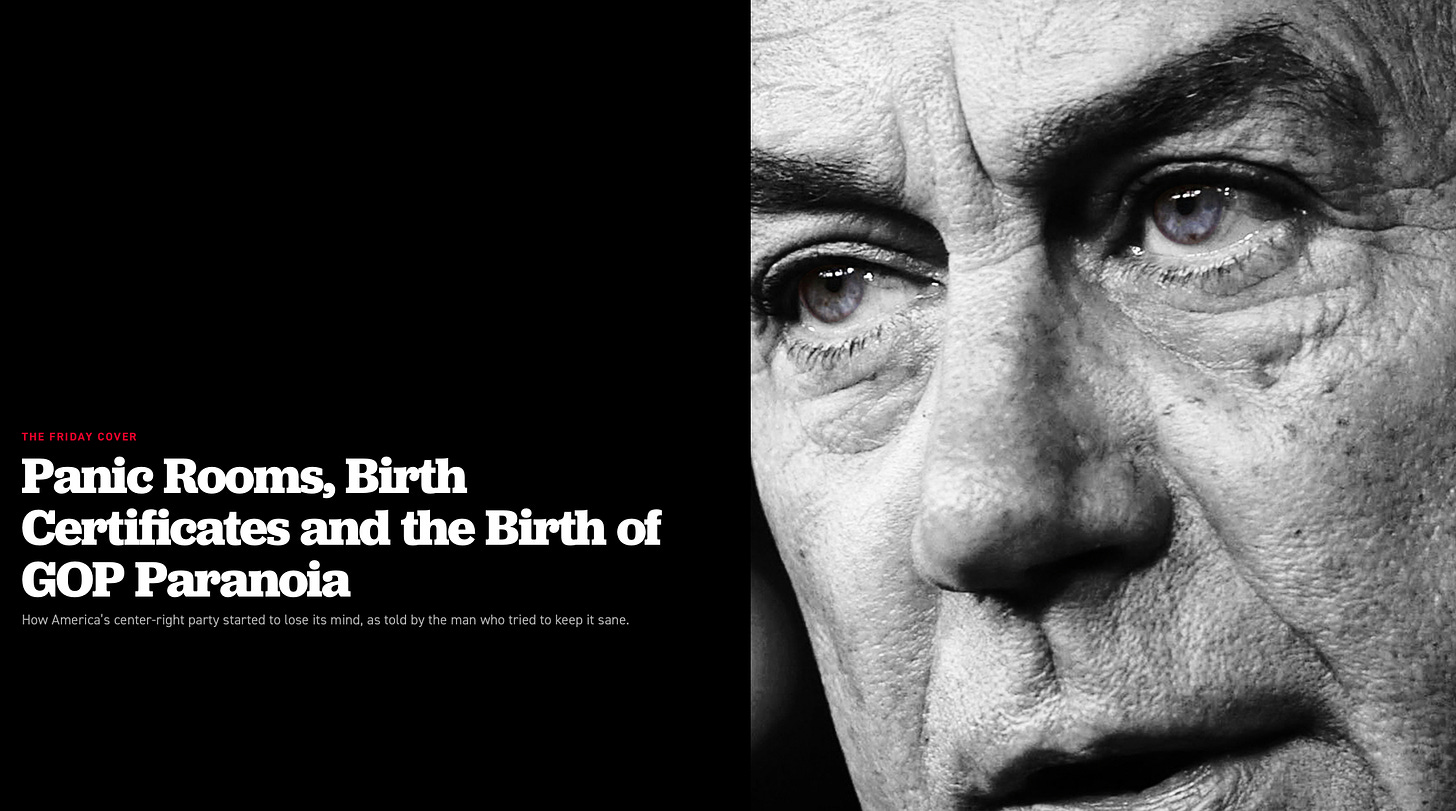

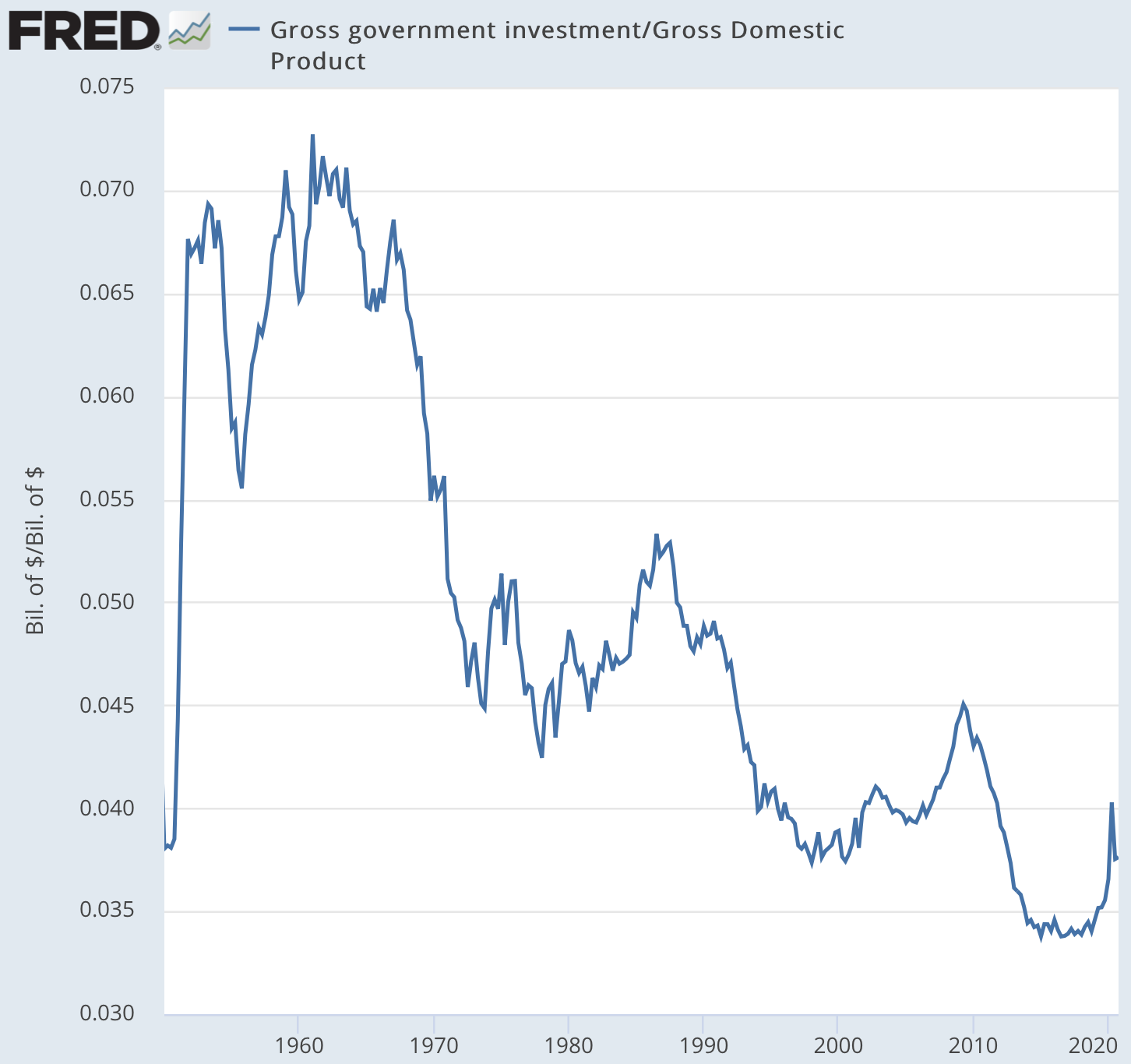
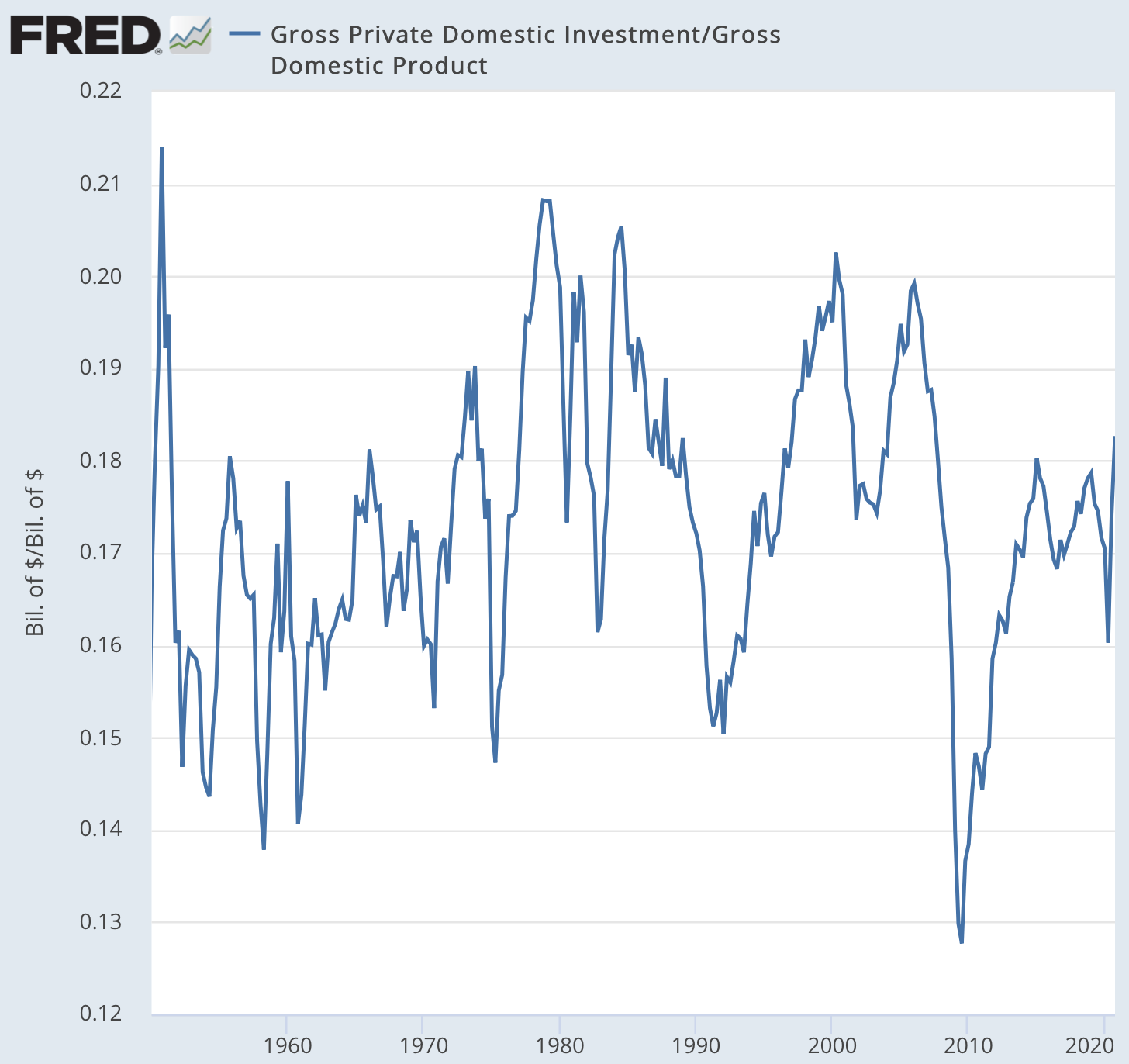

The neoconfederate, extractive, mammonite, and aristocratic wings of the republican party are all actively, consciously against any exercise of civil power. Their power requires a public sphere too weak to prevent their looting activities.
And it's not like they care about absolute economic measures; they care about relative economic measures, not overall wealth or opportunity.
So it's not "fear of change and dynamism"; it's fear of losing power. There's a corresponding commitment to a world in which the people who are winning now win forever, nothing important changes, and even if you can't literally own people, you can certainly capture their entire economic output.
As an objective, it's impressively deluded -- things are going to change more in the next fifty years than they have since our species came to be -- but that doesn't mean it's not real.